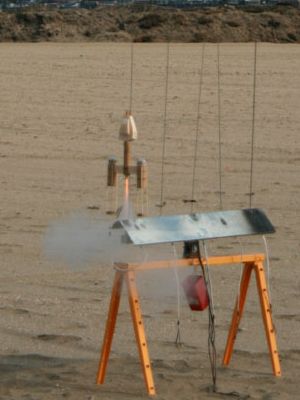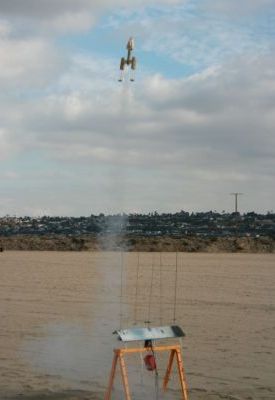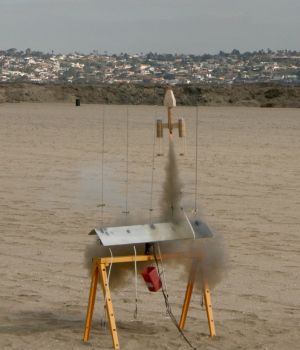Scratch Star Wars Y-Wing Fighter Original Design / Scratch Built
Scratch - Star Wars Y-Wing Fighter {Scratch}
Contributed by Todd Mullin
| Manufacturer: | Scratch |

Brief:
"The Koensayr BTL-S3 Y-Wing Attack Starfighter is an older craft, past it's prime by the Battle of Yavin but
still an important part of the Rebel Alliance. Though large and slow, it's extremely rugged and packs a heavy punch.
This craft is seen in all three Star Wars movies, starting with the first unsuccessful attack on the first Death
Star." - Starship Modeler
There are three reasons that I decided to do this build: First, because the Y-wing is just so darn cool and there hasn't been a kit released of this model. Second, I decided to make it out of recycled parts for the EMRR 2007 Challenge. And lastly, I built it to test the stability of the design for a larger version. Since this year is the 30th anniversary of the original Star Wars, TRASD has decided to build a large X-Wing and my build group thought that it should have a Y-Wing to fly with! For my boilerplate version I decided on 18mm motors and parachute recovery.
Construction:
This list of materials is probably unlike most of the reviews and articles found here on EMRR. The following parts
are needed to build yourself a similar project:
- 1 Paper towel tube
- 1 Fax paper tube
- 8 10" Bamboo shishkabob skewers
- 2 Plastic domes from grocery store novelty dispensers (the ones next to the gumball machines)
- 1 Pencil
- 1 Plastic grocery bag
- 1 18" piece of elastic from a never completed sewing project
- 1 36" piece of butcher's twine
- 1 Copperhead igniter tube
- 1 Sheet of newspaper
- 1 Sheet of corrugated cardboard
- 1 1/2"x4"x24" Piece of rough balsa packaging reinforcing material from an Edmonds Ecee Thunder kit (used to protect the thin laser cut sheets)
- 1 1/2" strip of 60 grit sandpaper
I started off my Y-Wing build with the side pods. By comparing the length to width of the paper towel tubes, I decided that they would look just about right by cutting the tube in half. I then trimmed off a 1/2" ring from each for the tail end of each pod. After that, I glued one of the paper towel tubes into the plastic domes. I then marked each tube using my Estes tube marking guide for four attachments. I glued the skewers on flush with the tail of the plastic dome with CA. The 1/2" cut off rings were then similarly marked and glued to the bamboo skewers. I eyeballed the approximate position of the rings and trimmed the excess pointed end of the skewer off. To finish off each side pod, I added 1/2" strips of corrugated carboard inside of the tail rings. Not only did this help the accuracy of the model, but I'm sure it added to it's stability as well.
After the side pods were complete, I moved on to the pod arms. I cut about a 2-1/2" piece off from the balsa plank and cut it in half to get two 2" x 2-1/2" pieces with the grain running perpendicular to the main body. I sanded concave curves in the attaching ends of these to match those of the paper towel and fax paper tubes. I used my normal gluing technique of putting a good amount of yellow carpenter's glue into the center of each pylon and tacked them to the end of the fax paper tube with CA and CA accelerator spray. This allows the part to be held in place quickly as the yellow glue dries to form a stronger bond. After bonding on both pod arms, I attached on the pods to each side.
The next task that I decided to do was to make the cockpit for the Y-Wing. I decided that one thickness of the balsa wasn't enough, so I laminated two together. This looked too thick, so I sloped it a bit on the bottom running from front to back. I then marked and cut the familiar wedge shaped cockpit with a hand saw. To complete the structure of the cockpit, I added another wedge shape for the canopy. This entire structure was lightly sanded.
Having the cockpit and side pods constructed, I used them to decide on the length to trim the main body fax tube to. I had several inches of tube left over, so I trimmed an inch off to use later for my shock cord mount. I took the remaining tube and cut a sliver out of it lengthwise. This allowed me to compress the cardboard in and tape it back together to use as a base for the nose cone. I glued this to the cockpit with CA and filled it in a bit with a mix of balsa sawdust and carpenter's glue as reinforcement.
Now that the major components of making the model look correct were in place, I needed to make it ready to actually fly. Since finding a scrap tube that was exactly the right size for a motor mount is difficult at best, I decided to roll my own tube for this. I started out by wrapping a standard 18mm motor with plastic wrap to prevent it from sticking to the glue of the rolled tube. I then cut a long strip of newspaper the same width as the motor. I wrapped this around the motor and kept rolling, adding a bit of glue every couple of inches. When I got to the end of the strip, I coated the outside of the tube with CA to give it a nice stiff and sandable surface. I trimmed and folded in half a strip of 60 grit sandpaper into a 1/4" x 2" piece which I glued into the front of the motor tube as a thrust ring. I cut centering rings to fit the motor tube and the fax tube from corrugated cardboard. The corrugated cardboard was soft and mushy as a thin ring and not very suitable for mounting just on it's own. To counter this, I loaded the rings up with Gorilla Glue and lightly sprayed them with water. I slipped the mount in place and sealed the end of the tube with gap filling CA. If you haven't used Gorilla Glue before here are two things to note: DO NOT get it anywhere you don't want it. It's like thick as molasses and very difficult to get off. Also, if it comes into contact with moisture as it cures, it foams and expands. When cured, the foam is hard, sandable, and tough! It's great for centering rings for odd sized tubes!
I was pretty pleased with the look of the model at this point, but it lacked the laser guns on the front of the cockpit. Looking around my workbench for something suitable, I finally settled on a sharpened end of a pencil. I trimmed it off and resharpened the remaining pencil and cut it again to match the other piece. I drilled a couple of holes in the front of the cockpit and dry fit the pencils in place.
At this point, I decided a swing test was in order. With a C6 motor installed, the CG was approximately 9-1/2" from the nose. The swing test seemed to go okay, but it wobbled a bit at low speed. I added a couple of balls of small lead shot to the holes for the pencils for insurance.
The model sat on my workbench for the next week getting fillets here and there as time permitted. The morning of the launch, I realized that I had to still install the shock cord and launch lug. At least I thought of this ahead of time instead of at the launch field as is normal... I split the remaining length of the fax paper tube in half lengthwise and cut slits in it to feed the shock cord through. This I glued into the main body tube and the nose cone base. I whipped out a quick parachute from the twine and plastic bag and attached it on to the shock cord.
Flight:
With the weight of the finished model coming in at about 4.5 ounces, I decided on an Estes C6-3 for the first flight.
I checked the shock cord to make sure that the glue had set solidly and it had. I dropped a diameter of dog barf
wadding into the body and packed the chute. It was a tight fit, but the nose cone coupler was long so there was plenty
of space in it for the chute. I friction fit the engine with masking tape and headed for the pads.
The LCO called out a "heads up" flight so everyone on the field was watching. Boy, I hoped that this wasn't going to go badly....
The motor lit and the Y-Wing boosted, nicely rolling on the way up. The model cleared about 250-300 feet. It ejected just after apogee, coming down slowly under chute with no damage.
Next, I wanted to try a higher thrust motor as the larger version would need to boost on a much larger motor. I loaded up a D13 reload, but the only delays I had were 7 second delays. I thought that this would be much too long, so I drilled the delay down a bit. I prepped the rocket for flight again and loaded it onto the pads. The motor sputtered a couple of times and came up to pressure, boosting perfectly straight but rolling again. As it was coasting past 350-400 feet, the ejection charge went off while it was still climbing fast. Looks like I drilled it a bit too much! The charge was very violent this time. The shock cord tore free of the mounts on both the cone and the airframe! Both halves of the rocket came spinning slowly down out of the sky hitting the sand 50 yards out from the flight line.



Recovery:
The impact on landing tore one of the wing pod arms free of the main body and crumpled the end of the tube badly. It
would be repairable, but I probably won't do anything with this as the model was mainly just a boilerplate testbed.
Summary:
I was really pleased that I was able to make a flying version of one of my all time favorite movie spaceships. Using
recycled materials let me not worry about accidentally goofing on "real" body tubes. I enjoyed just
eyeballing the proportioning of the model instead of being too uptight about getting it perfect. I was okay with stand
off (way off) scale as I mainly wanted to test stability.
The major con of the recycled tubes is that they have a problem holding together. They are a bit soft and get fuzzy when sanded. The wing pod ripped free due to the tube delaminating a couple of layers under a very solid glue joint. The shock cord mount was peeled apart in a way that I've not seen in a sturdier tube.
I will probably not rebuild this model but will make another with higher quality tubes and detail it more completely. I had a good time flying the model at this scale, but I am excited about the larger version as well!
 |
 |